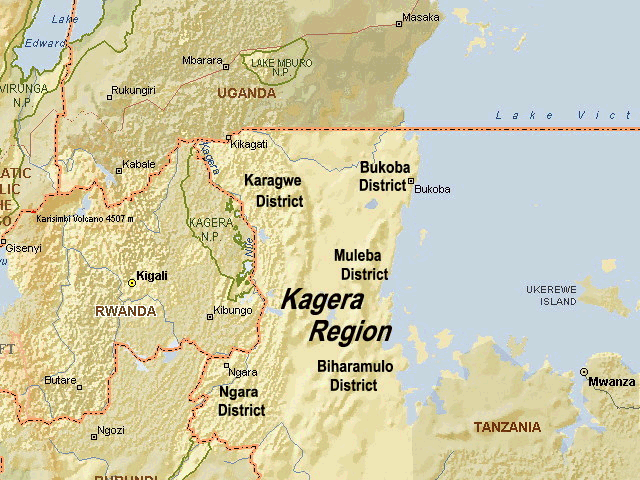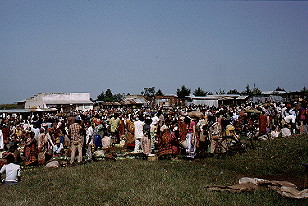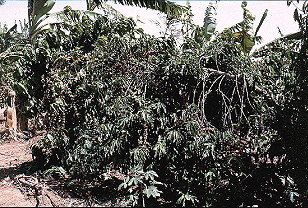|
General Description
The Kagera Region of the United Republic of
Tanzania lies wholly to the west of Lake Victoria. The northern border
of the Region, which also is an international border with Uganda, is
the 1°S parallel, westwards from Lake Victoria for some 100 km to
where the Kagera River crosses the parallel. From there, the Kagera
River, which follows a short, generally westward course then swings
almost due south, forms the western border. In its southward course
this is first with Rwanda then, after it passes through Ngara, with
Burundi. The total land area of the region is some 28,500 km².
The surface of Lake Victoria is 1134 m above sea level and almost all
of the land of the region all lies above about 1200 m. Because of the
effect of altitude, the climate can be described as modified
equatorial. There is little variation in the mean maximum and minimum
temperatures. In Bukoba, besides the lake, these rarely exceed 25°
C and rarely fall below 15°C. |
 |
|
Physical Geography
Lake Victoria itself lies at an altitude of
1134 m. An east to west transect across the Region from the shore of
the lake shows a series of ridges and broad valleys.
A series of photographs, taken by me and showing views of the
topography from east to west across the Region are linked from the
clickable VISTA.
The ridges, which in most places have a steep to sheer eastern
face, rise progressively higher from east to west. They reach a
maximum of some 1350 m along the lake and over 1700 m in the
westernmost ridge, which stretches the length of the Region.
The valley bottoms are almost all seasonally flooded or permanently
swampy land, with some smaller lakes. The Rainfall
Pattern, which basically is determined by the easterly
airflow off Lake Victoria and convection updraughts caused by the
ridges, is one of very high, over 2000 mm, in the environs of Bukoba,
declining to the west, to around 1000 mm, but with the valleys in
successive rainshadows. Areas with less than 750 mm of annual rainfall
are mostly uninhabited. Paralleling the decline in quantity, the
rainfall also becomes increasingly seasonal the further west the
location. |

|
|
Population
| The regional population in the 1978 census was 1,009,379.
This gives a population density of 35.5 per km² but, as a
consequence of the terrain and rainfall pattern, the cultivable
land, and those who cultivate it, is almost all on the ridgetops.
In several areas on the eastern ridges, the population density
nears 500 per km²; thus, ranking that in Bukoba District
among the highest rural densities in tropical Africa. The
available statistics on land under cultivation are undependable
and vary according to source. An estimate (based by the present
author on 1:50,000 scale maps and on other sources) of the major
problem area of banana cultivation, in the coastal strip some 40
km to the north and south of Bukoba, amounted to some 25,000 ha of
banana shambas, supporting over 35,000 households. At 4.5 persons
per household, the population density in this area is around 630
per km². Failure of the banana harvest would constitute a
major disaster to these people.
A modern FOOD SECURITY ATLAS OF KAGERA REGION can be found at
a
University
of Glasgow site with Digital Cartography and GIS by Mike
Shand. |
Market day in Ngara

|
| Typically the farmers of Kagera live on their shamba, giving
security to their food, bananas, and the "villagization"
programme of the post-independence government failed in the
Region. The major cash crop is the "robusta" coffee,
indigenous to the area. |
Traditional Wahaya house

|
| Robusta Coffee

|
"Modern" farmer's house

|
|
For administrative and political purposes, the Region is
divided into five Districts; Bukoba,
Muleba and Biharamulo
being on the eastern side, from north to south respectively;
Karagwe and
Ngara form the
western side, again north and south respectively. In addition
there is the Bukoba Urban District, where the Regional
Headquarters are situated. Below the District level there are
Divisions and these are further split into Wards, with a Ward
usually being made up of a number of villages.
To give some idea of the distances involved:- Bukoba by road
is some 1550 km, around two and a half days travelling time,
from Dar es Salaam; Bukoba to Muleba District Headquarters is 68
km, and to Biharamulo, 205 km; to Karagwe District HQ is 117 km
and to Ngara via Biharamulo 310 km, or via the more adventurous
Karagwe route, 240 km.
|
 NEXT NEXT
©2000 - Brian Taylor CBiol
FIBiol FRES
11, Grazingfield, Wilford, Nottingham, NG11 7FN, U.K.
Visiting Academic in the Department of Life Science, University of
Nottingham |
href="\BANANAS2000\KAGERA.HTM" |

